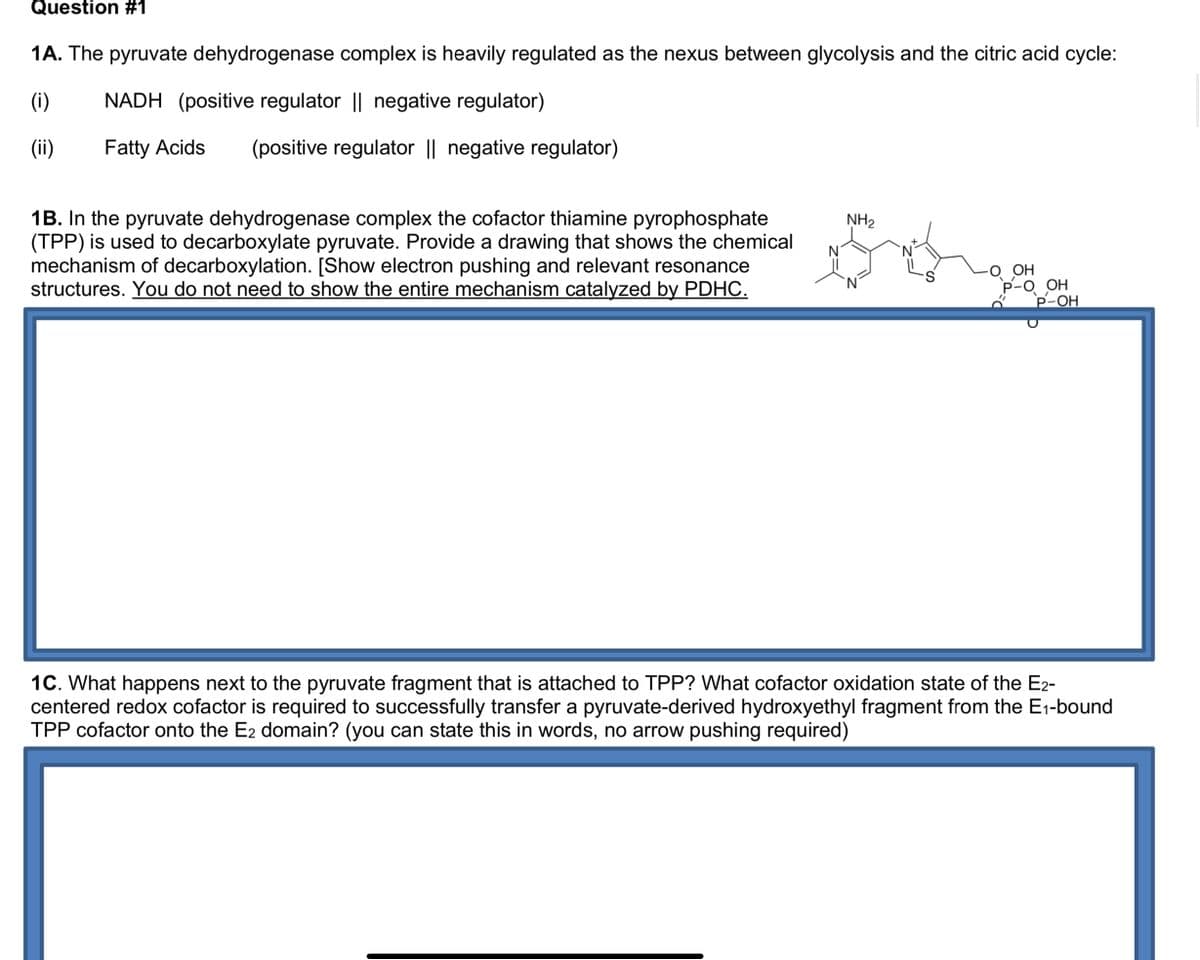Please help with 1a) 1b) and 1c) ! If cant do all, then as much as you can, thank you!
Please help with 1a) 1b) and 1c) ! If cant do all, then as much as you can, thank you!
Biochemistry
9th Edition
ISBN:9781319114671
Author:Lubert Stryer, Jeremy M. Berg, John L. Tymoczko, Gregory J. Gatto Jr.
Publisher:Lubert Stryer, Jeremy M. Berg, John L. Tymoczko, Gregory J. Gatto Jr.
Chapter1: Biochemistry: An Evolving Science
Section: Chapter Questions
Problem 1P
Related questions
Question
Please help with 1a) 1b) and 1c) ! If cant do all, then as much as you can, thank you!

Transcribed Image Text:Question #1
1A. The pyruvate dehydrogenase complex is heavily regulated as the nexus between glycolysis and the citric acid cycle:
(i)
NADH (positive regulator || negative regulator)
(ii)
Fatty Acids (positive regulator || negative regulator)
NH₂
1B. In the pyruvate dehydrogenase complex the cofactor thiamine pyrophosphate
(TPP) is used to decarboxylate pyruvate. Provide a drawing that shows the chemical
mechanism of decarboxylation. [Show electron pushing and relevant resonance
structures. You do not need to show the entire mechanism catalyzed by PDHC.
OH
P-OOH
P-OH
1C. What happens next to the pyruvate fragment that is attached to TPP? What cofactor oxidation state of the E2-
centered redox cofactor is required to successfully transfer a pyruvate-derived hydroxyethyl fragment from the E₁-bound
TPP cofactor onto the E₂ domain? (you can state this in words, no arrow pushing required)
Expert Solution
This question has been solved!
Explore an expertly crafted, step-by-step solution for a thorough understanding of key concepts.
Step by step
Solved in 5 steps with 2 images

Recommended textbooks for you

Biochemistry
Biochemistry
ISBN:
9781319114671
Author:
Lubert Stryer, Jeremy M. Berg, John L. Tymoczko, Gregory J. Gatto Jr.
Publisher:
W. H. Freeman

Lehninger Principles of Biochemistry
Biochemistry
ISBN:
9781464126116
Author:
David L. Nelson, Michael M. Cox
Publisher:
W. H. Freeman

Fundamentals of Biochemistry: Life at the Molecul…
Biochemistry
ISBN:
9781118918401
Author:
Donald Voet, Judith G. Voet, Charlotte W. Pratt
Publisher:
WILEY

Biochemistry
Biochemistry
ISBN:
9781319114671
Author:
Lubert Stryer, Jeremy M. Berg, John L. Tymoczko, Gregory J. Gatto Jr.
Publisher:
W. H. Freeman

Lehninger Principles of Biochemistry
Biochemistry
ISBN:
9781464126116
Author:
David L. Nelson, Michael M. Cox
Publisher:
W. H. Freeman

Fundamentals of Biochemistry: Life at the Molecul…
Biochemistry
ISBN:
9781118918401
Author:
Donald Voet, Judith G. Voet, Charlotte W. Pratt
Publisher:
WILEY

Biochemistry
Biochemistry
ISBN:
9781305961135
Author:
Mary K. Campbell, Shawn O. Farrell, Owen M. McDougal
Publisher:
Cengage Learning

Biochemistry
Biochemistry
ISBN:
9781305577206
Author:
Reginald H. Garrett, Charles M. Grisham
Publisher:
Cengage Learning

Fundamentals of General, Organic, and Biological …
Biochemistry
ISBN:
9780134015187
Author:
John E. McMurry, David S. Ballantine, Carl A. Hoeger, Virginia E. Peterson
Publisher:
PEARSON